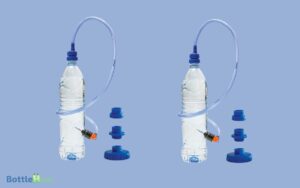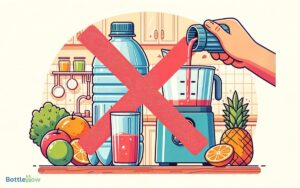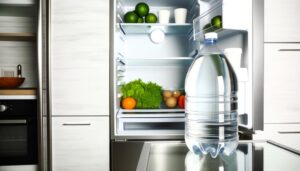Is Smart Water Bottle Bpa Free
Yes, many smart water bottles are BPA-free, prioritizing safety and health. BPA, or bisphenol A, found in some plastics, can disrupt endocrine function by mimicking hormones, posing long-term health risks such as reproductive harm and cancer.
Popular BPA-free smart water bottles use safe materials like stainless steel, Tritan, or borosilicate glass, ensuring durability and non-toxicity. Look for explicit 'BPA-free' labels and certifications from trusted organizations to verify safety.
Considering various brands can help you identify features and materials that best match your needs, leading to better-informed decisions on your hydration habits.
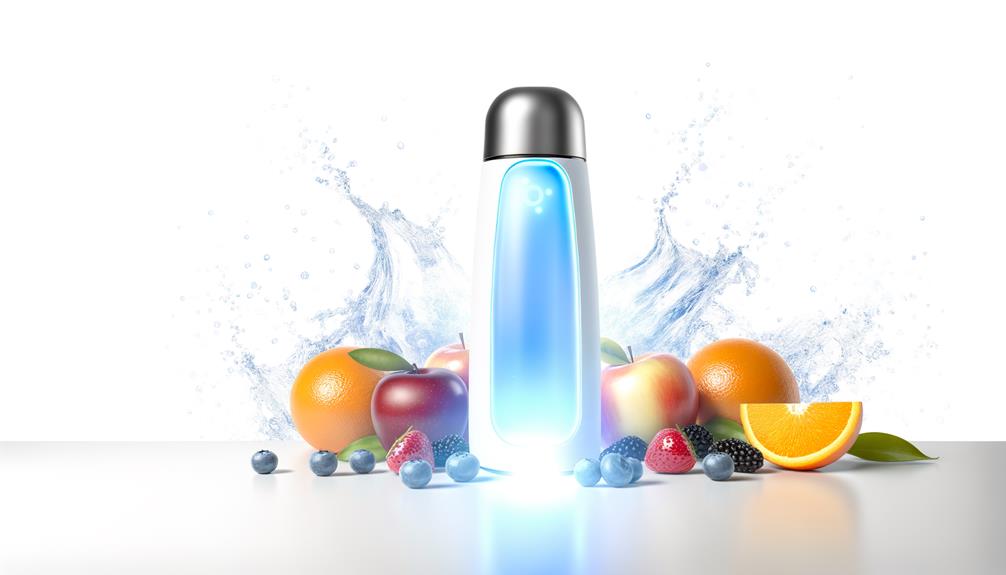
Key Takeaways
- Many smart water bottles are made from BPA-free materials like Tritan, stainless steel, or borosilicate glass.
- Always check for a 'BPA-free' label on the product packaging or manufacturer's website.
- Popular brands like HidrateSpark, Thermos, and Gululu offer BPA-free smart water bottles.
- BPA-free certification can be verified through third-party organizations like NSF International and FDA.
Understanding BPA
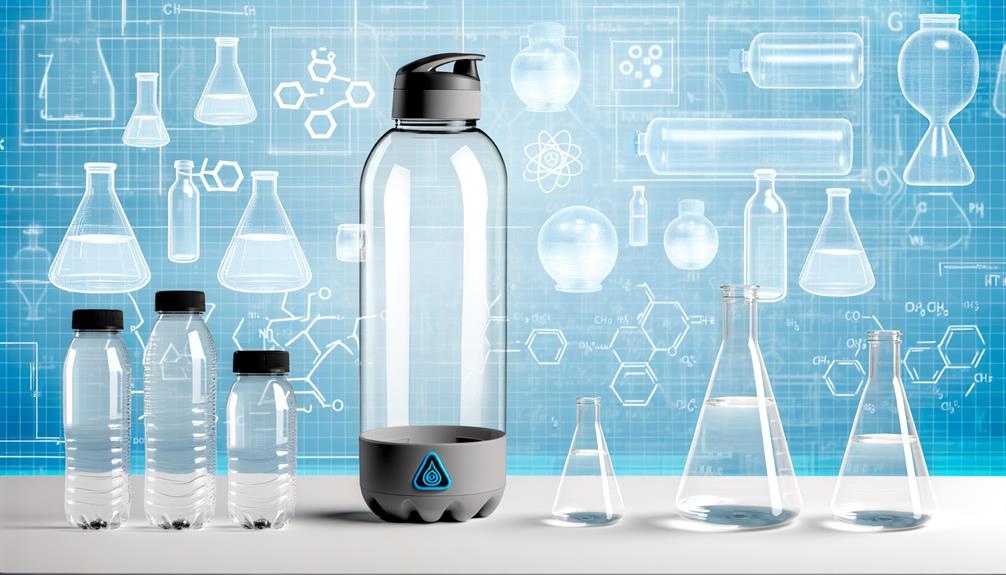
For a thorough understanding of BPA, it's essential to recognize that this chemical compound, also known as bisphenol A, is widely used in manufacturing various plastic products.
You'll find BPA in items like water bottles, food containers, and even the lining of metal cans. Its primary function is to enhance the durability and clarity of plastics.
BPA is a synthetic organic compound with the chemical formula (CH₃)₂C(C₆H₄OH)₂. It's known for its ability to mimic estrogen, although we won't explore health implications here. Understanding its chemical structure helps you appreciate why it's so effective in plastic production.
Health Risks of BPA
You should be aware that BPA, or bisphenol A, can disrupt endocrine function, mimicking the body's hormones and interfering with their normal activities.
Prolonged exposure to BPA is linked with various health issues, including reproductive disorders and increased cancer risks.
Understanding these health risks underscores the importance of choosing BPA-free products for daily use.
Hormonal Disruption Concerns
Bisphenol A (BPA), commonly found in many plastic products, has been linked to significant hormonal disruption, posing substantial health risks.
When you consume beverages from containers containing BPA, it can leach into the liquid, subsequently entering your body. BPA mimics estrogen, binding to hormone receptors and interfering with endocrine function.
This disruption can lead to various health issues, including reproductive disorders, developmental problems in children, and increased risk of certain cancers. Studies have demonstrated that even low levels of BPA exposure can have adverse effects.
As a result, it's crucial to choose BPA-free products, like smart water bottles, to minimize your exposure and protect your hormonal health. Always verify product labels to verify safety standards are met.
Long-term Exposure Effects
Long-term exposure to BPA has been associated with a spectrum of serious health risks that warrant close attention and preventive measures. Studies indicate that BPA can disrupt endocrine function, leading to various health issues over time.
You should be aware of the following potential risks:
- Reproductive Harm: BPA exposure has been linked to reduced fertility and developmental issues in offspring.
- Cardiovascular Diseases: Chronic exposure may increase the risk of hypertension and heart disease.
- Metabolic Disorders: There's evidence suggesting a connection between BPA and conditions like obesity and diabetes.
To mitigate these risks, opting for BPA-free products, such as smart water bottles, is a prudent choice. Your health and well-being are worth the preventive effort.
BPA in Everyday Products
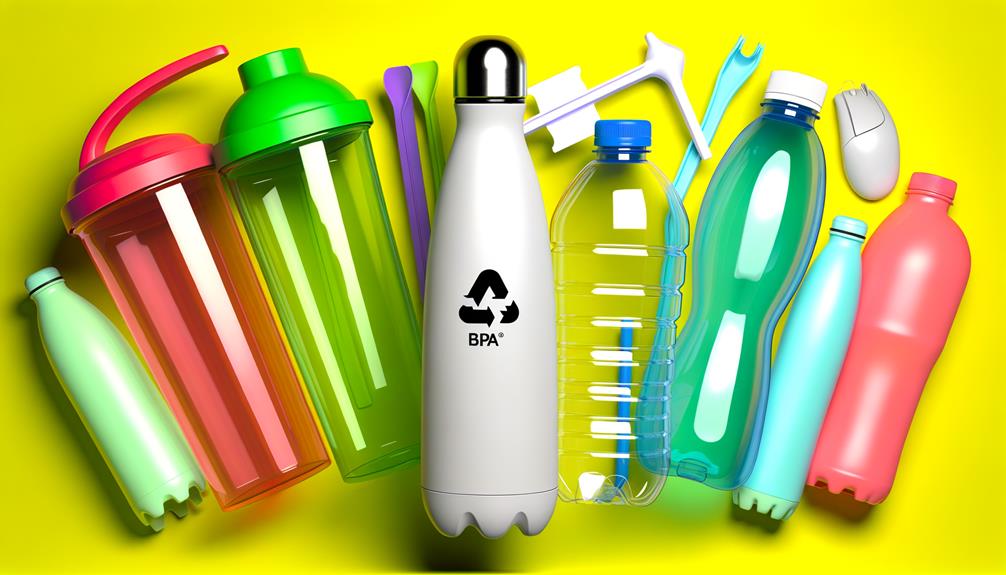
You're likely exposed to BPA through various everyday products, including plastic containers, canned foods, and thermal paper receipts.
Studies have linked BPA exposure to adverse health effects such as hormonal disruptions and increased risks of certain cancers.
To mitigate these risks, it's essential to identify BPA-free alternatives and adopt practices to reduce your exposure.
Common BPA Sources
Many everyday products, including plastic containers, canned goods, and thermal paper receipts, are common sources of BPA exposure. You mightn't realize it, but BPA is prevalent in items you use frequently.
Specifically, BPA can leach into food and drinks from:
- Plastic containers: Many plastic food and beverage containers, especially those marked with recycle codes 3 or 7, often contain BPA.
- Canned goods: The epoxy resins used in the lining of many canned foods and beverages can release BPA into the contents.
- Thermal paper receipts: These receipts, commonly used in point-of-sale systems, are coated with BPA to develop print when heated.
Understanding these sources helps you make informed choices about reducing your BPA exposure.
Health Risks Explained
Exposure to BPA from everyday products like plastic containers and canned goods can pose significant health risks, including hormonal disruptions and increased susceptibility to certain diseases.
Research indicates that BPA can mimic estrogen, potentially leading to endocrine system interference. This hormonal mimicry is linked to conditions such as breast and prostate cancer, reproductive issues, and developmental problems in children.
Additionally, BPA exposure has been associated with metabolic disorders, including insulin resistance and obesity. The chemical's ability to leach into food and beverages exacerbates its impact.
Long-term exposure can lead to chronic health issues, making it imperative to understand the risks. By recognizing BPA's potential dangers, you can make informed decisions about product usage.
Avoiding BPA Exposure
To avoid BPA exposure, it's crucial to identify and minimize contact with everyday products that commonly contain this chemical. BPA, or Bisphenol A, often leaches into food and beverages from certain plastics and resins. You can reduce your exposure by:
- Choosing BPA-free containers: Opt for glass, stainless steel, or BPA-free plastics when selecting water bottles, food storage, and kitchenware.
- Avoiding canned foods: Many cans are lined with BPA-containing resin. Instead, choose fresh or frozen foods.
- Checking recycling codes: Plastics marked with the recycling codes 3 or 7 may contain BPA. Select products labeled as BPA-free or those with recycling codes 1, 2, 4, 5, and 6.
What Are Smart Water Bottles?
Smart water bottles are innovative hydration devices designed to track your water intake, remind you to drink, and sync data with your smartphone. These bottles use integrated sensors and Bluetooth technology to monitor your consumption patterns, ensuring you stay adequately hydrated. They often come with LED indicators or smartphone notifications to alert you when it's time to drink.
Here's a quick overview of key features you might find in smart water bottles:
| Feature | Description |
|---|---|
| Hydration Tracking | Monitors your daily water intake and logs data in an app |
| Reminders | Provides alerts to prompt you to drink water |
| Temperature Monitoring | Measures and displays the current temperature of the water |
| Syncing | Connects with health apps to integrate hydration data |
These features make smart water bottles an essential tool for maintaining ideal hydration levels.
Materials Used in Smart Water Bottles
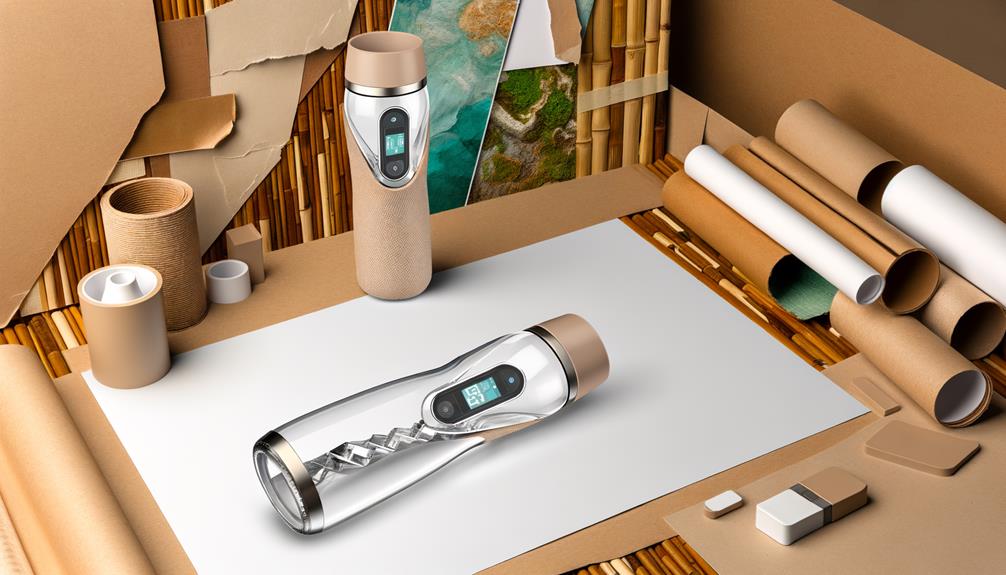
When choosing a smart water bottle, it's vital to take into account the materials used in its construction to guarantee safety and durability.
The primary materials you'll encounter include:
- Stainless Steel: Known for its corrosion resistance and non-reactivity, stainless steel guarantees your water remains free of contaminants.
- Borosilicate Glass: This high-quality glass is resistant to thermal shock and doesn't leach chemicals, providing a safe drinking experience.
- Food-Grade Plastics: Often used for their lightweight and durability, these plastics must be scrutinized for BPA-free certification to confirm they're safe for daily use.
Each material has distinct properties that contribute to the performance and safety of the smart water bottle, making it important to understand their implications for your health.
Identifying BPA-Free Labels
Identifying BPA-free labels on smart water bottles involves scrutinizing product packaging and manufacturer information to confirm the materials used are safe and non-toxic.
You should first look for explicit 'BPA-free' labels on the packaging. These labels are often prominently displayed due to consumer demand for safe products.
Additionally, examine the material composition listed; BPA-free bottles typically use alternatives like Tritan, stainless steel, or glass.
Verify claims by consulting the manufacturer's website or third-party certifications, such as NSF International or the FDA, which provide assurance of compliance with safety standards.
Don't overlook user reviews and expert opinions, as they can reveal insights into the product's safety and reliability.
Popular BPA-Free Smart Bottles
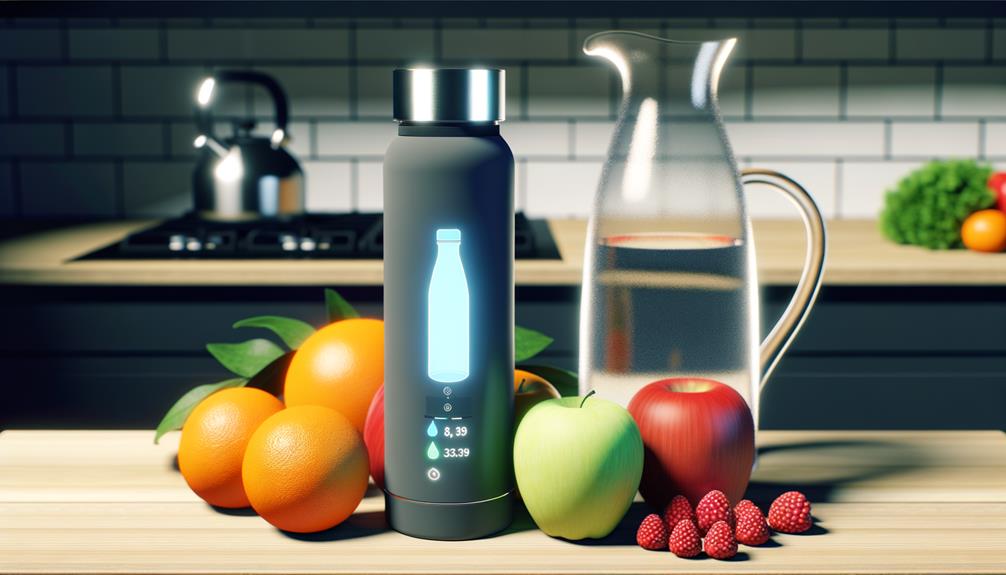
You’ll find several popular BPA-free smart water bottles on the market that combine advanced technology with safe, non-toxic materials. These bottles offer a range of features to enhance your hydration experience while ensuring your health isn’t compromised. Some models track your water intake through a mobile app, while others remind you to hydrate with glowing LED lights or notifications. If you’re wondering, are Gatorade water bottles BPA free, many of their bottles are made from BPA-free plastic, ensuring they are a safer choice for daily use. With these smart water bottles, staying hydrated has never been easier or more convenient.
Here are three notable examples:
- HidrateSpark 3: Utilizes a LED sensor to track your water intake and syncs with a mobile app, ensuring you stay hydrated throughout the day.
- Thermos Connected Hydration Bottle: Equipped with a smart lid that monitors your fluid consumption and provides real-time data via an integrated app.
- Gululu Interactive Bottle: Targets children by gamifying hydration through a digital pet, encouraging consistent water intake.
These options exemplify the integration of technology and health-conscious design.
Comparing Smart Bottle Brands
Having explored popular BPA-free smart water bottles, it's important to compare the leading brands to determine which one best meets your specific hydration needs and preferences. Below, you'll find a comparative analysis focusing on key features such as battery life, connectivity, and additional functionalities:
| Brand | Battery Life | Connectivity | Additional Features |
|---|---|---|---|
| HydrateSpark 3 | 5-7 days | Bluetooth | App integration, customizable LEDs |
| Thermos Smart Lid | 12 days | Bluetooth | Temperature sensor, hydration tracking |
| HidrateSpark STEEL | 14 days | Bluetooth | Stainless steel, LED reminders |
These brands have been evaluated based on their technical specifications. HydrateSpark 3 offers customizable LEDs, while Thermos Smart Lid provides temperature monitoring. The HidrateSpark STEEL stands out with its longer battery life and durable build.
Making an Informed Choice
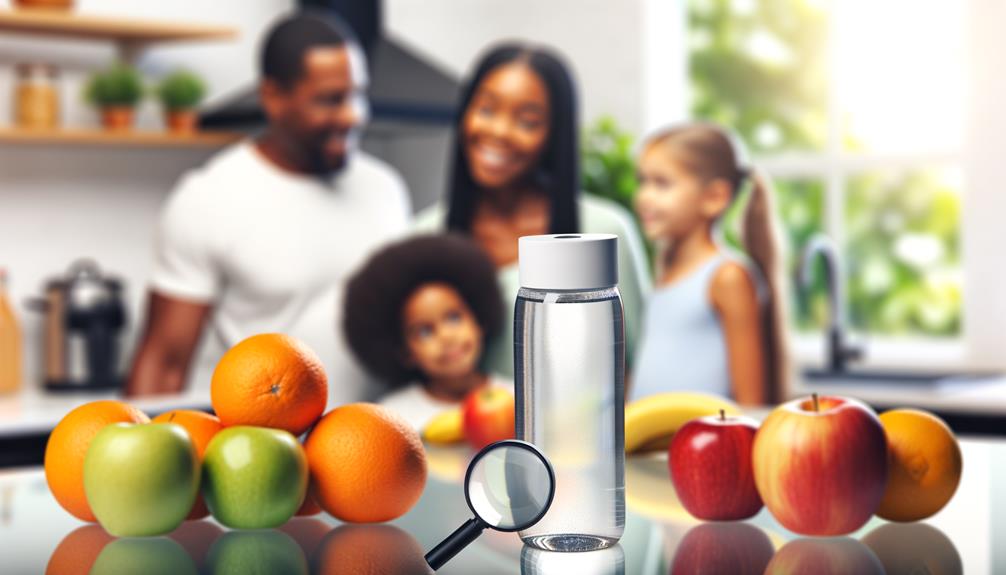
Choosing the right smart water bottle involves evaluating your specific hydration requirements, lifestyle, and the distinct features each brand offers. To make an informed choice, consider the following factors:
- Material Safety: Confirm the bottle is BPA-free to avoid potential health risks associated with bisphenol A.
- Smart Features: Look for features like hydration tracking, reminders, and integration with fitness apps to support your health goals.
- Battery Life: Assess battery longevity and charging options to guarantee the bottle meets your daily usage needs without frequent interruptions.
Conclusion
Imagine holding a sleek, modern smart water bottle in your hand, knowing it's free from harmful BPA. This peace of mind stems from understanding BPA's risks and the rigorous materials used in BPA-free smart bottles.
With reliable brands and clear labels guiding your choice, you're empowered to make a health-conscious decision. As you take a sip, trust in the science-backed safety and enjoy hydration without worry.
Your well-being deserves nothing less.


